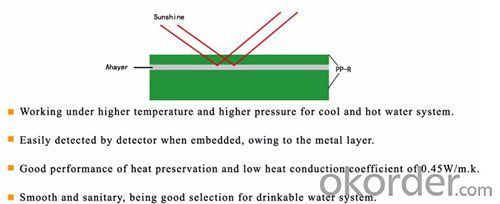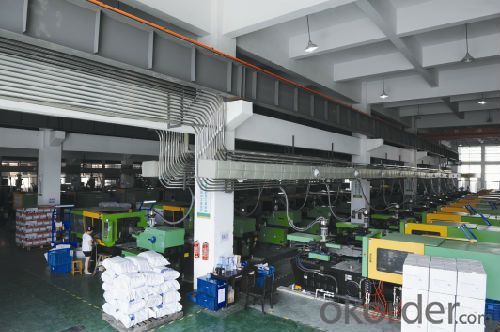Loading Port:Tianjin
Payment Terms:L/C,T/T
Min Order Qty:45000 pc
Supply Capability:1800000 pc/month
Product Features
1. Corrosion resistance
PPR pipes and fittings can resistant to most chemical corrosion; it can withstand PH value range 1-14 high concentration of acid and alkali corrosion over a wide temperature range.
2. Installation performance
PPR pipe PPR pipe is light in weight, and the operation installation is easy, which make it available to weld again. It is very important that pipe and pipe fittings can be welded together in seconds with a simple tool. Compared to traditional connection methods it can save 40%~50% of the time.
3. Safety Indicators
The basic component of PPR is carbon and hydrogen which is simple. It keeps in line with food hygiene regulations, non-toxic. If you use PPR pipe, there will no dirt in the inner wall or “secondary water pollution” caused by rust any more.PPR pipe ,green building materials, is more suitable for transporting drinking water.
Advantages of PPR pipe
1. Maximum operating temperature can up to 95℃; it can work in a long term under the condition of 70℃ and 1.0Mpa.
2. PPR pipe density is only 1/8 of metal pipe; pressure resistance strength test is up 5Mpa, with good toughness, impact resistance.
3. Inner diameter of PPR pipe is little bigger than that of pipe fittings, which can ensure not to increase the resistance to fluid flow.
4. Inner wall of PPR pipe is smooth, no rust, no scaling, small fluid resistance
5. PPR pipe has excellent insulation properties, can significantly reduce the vibration and noise caused by the flow of liquid.
6. PPR pipe energy consumption is only 20% of steel pipe; its thermal coefficient is also only 1/200 of steel pipe, reducing heat loss greatly.
7. PPR pipe is poor electrical conductor material, which can avoid galvanic corrosion phenomena.
8. With poor thermal conductivity, PPR pipe can reduce condensation.
9. PPR pipes, fittings are recyclable.









Application
1. Hot and cold drinking water supply system of civil and industrial buildings
2. Clean, pure water piping system
3. Beverage production and transport systems
4. Industrial liquid delivery system
5. Central air conditioning system
6. Hot water circulation Heating System
7. Compressed air piping system
8. Garden and greenhouse irrigation systems
PPR pipe also known as three polypropylene pipe using a random copolymer polypropylene by extrusion become pipe, injection molded into the tube. PPR pipe is the development and application of new plastic pipe products in the early 1990s of the European. The late 1980s, PPR is the use of a gas phase copolymerization process so that about 5% PE in the molecular chain of PP random homogeneous polymerization (random copolymer) and a new generation of pipe materials. It has a good impact resistance and long-term creep performance.
PPR pipes have the features of light weight, corrosion resistance, no scaling, long life, but also have the following characteristics:
1. Non-toxic health: raw material molecule only carbon and hydrogen elements, not only for hot and cold water pipes, can be used to clean drinking water systems;
2. Energy-saving insulation: pipe thermal conductivity 0.21W / MK, steel is only 1/200;
3. Better heat resistance: PPR pipe Vicat softening point of 131.5 ℃, the maximum working temperature up to 95 ℃, can meet the water supply and drainage requirements specification hot water system;
4. Long life: PPR operating temperature 70 ℃, working pressure (PN) conditions under 1.0Mpa life of up to 50 years at room temperature (20 ℃) the service life of up to 100 years;
5. Install reliable connection: PPR pipe has good weld ability, pipe fittings can be used hot-melt and fused connections, easy installation, reliable joints, the strength of joints is greater than the strength of the pipe itself;
6. Recyclable materials: does not affect product quality.
How to choose a safe and economical PPR pipe?
1. Note that the overall pipeline utilization factor C (that is, the safety factor) is determined. General case, and long-term continuous use temperature is less than 70 ℃, optional C is equal to 1.25. On important occasions and long-term continuous use temperature of greater than or equal to 70 ℃, and is likely to run at a higher temperature for a long time, an optional C = 1.5;
2. For cold water (≤40 ℃) system, the choice of PN1.0 ~ 1.6Mpa pipe, fittings, hot water system for the selection of greater than or equal to 2.0Mpa pipe, tube.